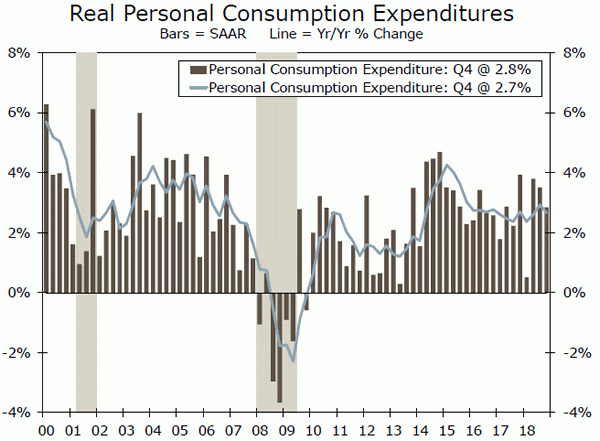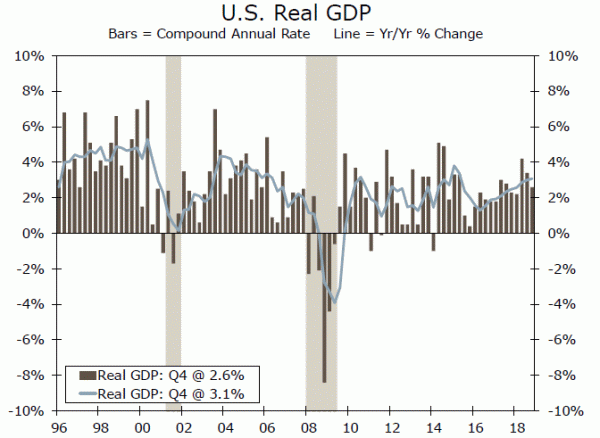Although real GDP growth slowed in the fourth quarter, the stronger-than-expected outturn should alleviate some concerns that the economy is in serious trouble.
Deceleration in PCE Leads to Slower GDP Growth
Data released this morning, which had been delayed due to the government shutdown, showed that real GDP in the United States grew at an annualized rate of 2.6% in Q4-2018 relative to the previous quarter (top chart). The outturn was stronger than the 2.2% rate that the market consensus had expected, but it still represents a stepdown from the very strong growth rates that were registered earlier in the year.
The breakdown of the GDP data into its underlying demand components showed that the deceleration was led by real personal consumption expenditures (PCE), which grew 2.8% in Q4 (middle chart). Real PCE was boosted, at least in part, earlier in the year from the personal tax cuts that were part of the Tax Cuts and Jobs Act (TCJA) of December 2017. Although the real income-boosting effects of the tax cuts will fade over time, income growth should remain solid due to the robust labor market. Not only has employment growth remained strong, but wages are now rising at a decent clip. Although growth in real PCE is not likely to rebound to the rates that were registered earlier in 2018, we look for PCE to grow at a 2%-plus clip in coming quarters.
Business fixed investment (BFI) spending, which grew only 2.5% in Q3-2018, rebounded to a growth rate of 6.2% in Q4 (bottom chart). That said, the construction component of BFI spending remained weak. Non-residential construction spending slipped 4.2%, which likely reflects weakness in the energy sector. In addition, residential construction fell for the fourth consecutive quarter, a victim of the one-two punch of rising house prices and higher mortgage rates. Looking forward, recent data on durable goods orders suggest that growth in capital spending likely will be anemic in the first half of 2019. In short, there really has not been a sustained acceleration in BFI spending as some analysts had hoped a year or two ago.
The effects of the government shutdown, which started in December, also showed up in the data as non-defense federal government spending tumbled at an annualized rate of 5.6% in Q4. Because the shutdown lasted into January, this component of spending likely will be weak in Q1 as well before rebounding in Q2. Some inventory building added a bit to topline GDP growth, although net exports exerted some modest headwinds.
The stronger-than-expected GDP outturn should alleviate some concerns that the economy is in serious trouble. Our current forecast looks for further deceleration in the first quarter—we look for real GDP to grow roughly 2% in Q1—but we look for a modest rebound starting in Q2. Growth is probably not strong enough right now to induce the Fed to resume its tightening cycle. But we look for the FOMC to tap on the brakes again with another 25 bps rate hike later this year (probably sometime in the third quarter).

















